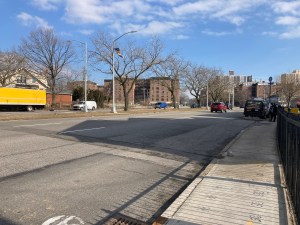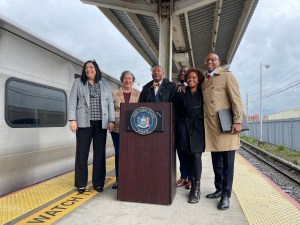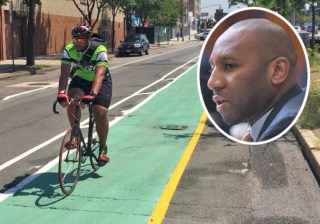CM Richards: Far Rockaway Needs Good Transit+Biking, Not More Parking

How can downtown Far Rockaway’s transportation system handle the growth in housing and commercial development that City Hall is planning for the beachside community? To hear some local bigwigs tell it, the answer is parking, parking, and more parking. But Council Member Donovan Richards has different ideas.
The de Blasio administration has committed $91 million to street infrastructure, commercial development, and public services for downtown Far Rockaway in tandem with a rezoning in its affordable housing plan. At a hearing on the proposed rezoning last night, most people could only talk about one thing: parking.
“The success of downtown Far Rockaway is going to be the ability to attract people from surrounding communities, including Nassau County, and they’re not going to be able to do it on [public] transportation,” said Marty Ingram, co-chair of Queens Community Board 14’s transportation committee.
While the rezoning plan is not final, the draft environmental impact assessment anticipates lower parking requirements that “more closely reflect automobile ownership rates within the area,” which are low compared to the rest of the peninsula. Excessive parking minimums drive up the cost of housing.
That was a sticking point for many other attendees, some of whom pointed to existing traffic problems as justification for more parking.
“People who are going to move here are going to have cars, they need to park, and if this is going to be the beautiful shopping area that we want it and we believe it’s going to be, people are going to drive here,” CB 14 District Manager Jonathan Gaska said. “The city’s dream that people are going to ride their bikes to Rockaway and shop… is just not going to happen.”
Council Member Richards, who has spearheaded the rezoning process, had a different take. He said the neighborhood has a “legitimate parking issue” but that improving transit and bike infrastructure — not building more parking — is the most promising way to address those problems.
“The idea is also to make sure we activate different modes of transportation,” Richards told Streetsblog. “The more transportation alternatives for everybody, the better for everyone. So bicycling, better A Train service, more SBS service. These things are paramount to ensure that this project is a success.” Richards also expressed interest in bringing Citi Bike to the neighborhood.
Richards said that lowering parking requirements is essential to maximizing the amount of affordable housing in the plan. “Listen, there’s an affordable housing crisis right now,” he said. “People have to live somewhere, so the idea is to create affordable, mixed-income housing in the community.”
In the spring, DOT will release initial recommendations from the “Access to Opportunity” study of the Eastern Rockaways’ transportation and housing needs. Those ideas are expected to address bus service, bike connections, and the reliability of subway and Long Island Railroad service [PDF].
Additionally, next summer the agency will begin a full reconstruction of major streets in the neighborhood. The project includes new painted crossings, expanded sidewalks, and a new plaza and “shared streets” space outside the Mott Avenue A Train station [PDF].

Absent from the initiative so far is any type of bike infrastructure. An improved bike network was among the recommendations made by a local coalition known as the Downtown Far Rockaway Working Group, but EDC’s response makes no mention of biking or bike infrastructure.
Last night, several people who spoke mocked the idea of biking around downtown Far Rockaway, and the audience could be heard grumbling or laughing at the idea.
One voice in favor of incorporating bike infrastructure was Daniel Solow, who bikes to the Mott Avenue A Train every day from his home in Nassau County.
“I was very disappointed that I didn’t see the word bicycle in any of these projects,” Solow told the audience. “I hope that everyone here keeps an open mind to different transportation solutions that don’t cost as much as parking.”



